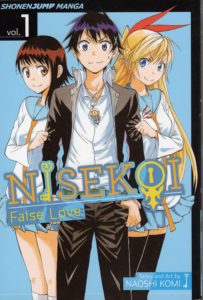Manga Review: Nisekoi by Naoshi Komi
Raku Ichijo is a mild-mannered teenager who just happens to be the heir-apparent to the Shuei-Gumi Yakuza clan. He wants nothing to do with this, intending to become a strait-laced civil servant when he grows up. Raku also dreams of romance. He has a lock pendant from ten years ago, that he promised to keep so a girl could unlock it with her key and they would get married. Unfortunately, he no longer remembers the girl’s name or appearance. But he wouldn’t mind if she was his current crush, Kosaki Onodera, who is sweet and shy.
However, another girl comes crashing into Raku’s life, knee to face first. She’s Chitoge Kirisaki, a boisterous, half-American girl who’s very pretty and athletic, but sorely lacking in proper deportment. Raku and Chitoge get on like mongoose and viper, each seeing the other as the source of problems. (Most notably, Chitoge accidentally caused Raku’s pendant to go missing.) Over the next couple of weeks, being constantly thrown together allows them to learn each other’s bad points and some of their good, but at last it looks like they’ve reached a truce.
It’s at this point that Raku’s father announces that in order to make a truce with the new criminal organization in the city, the Beehive Gang, Raku must enter into a false relationship (the nisekoi of the title) with the daughter of that gang’s leader. Who is, of course, Chitoge. In order to keep peace between the gangs, they must pretend to be lovey-dovey, while in reality they drive each other up the wall!
Legend has it that Komi’s previous series, Double Arts, was innovative and took some creative risks, but struggled to find an audience and was cut short. So he deliberately made this romantic comedy series as cliched as possible, but as well-written as he could manage to capture sales and series longevity. And yes, many elements of the series are very predictable. Of course Onodera secretly has a crush on Raku she’s too shy to ever act on. Of course Raku and Chitoge find themselves growing closer even as they valiantly struggle against such feelings. Of course new wacky characters appear to cause more complications in their lives as the circumstances force them into sitcom antics.
Most of the time, it’s done quite well, and is enjoyably readable. There’s just enough of a twist at times to keep it from being completely obvious, and most of the characters are kind of likable when they aren’t being sitcom stupid.
Like many Shounen Jump series, there was a long period in the middle where the manga seemed to be spinning its wheels, doing fun stories, but no real plot advancement. Then about a year real time before the series ended, Komi started resolving plot points one after another, devoting arcs to clearing away the complications that prevented the central relationship from advancing. The ending, while also in its way cliched, was very satisfying.
There’s also an anime adaptation of the early part of the manga.
I have the first volume to hand. After the initial set-up, Raku and Chitoge are forced to go on their first (fake) date, which is something of a disaster, especially when Onodera stumbles on them together, and is convinced the relationship is real. There’s also the reveal that Onodera wears a key pendant that looks like it might fit Raku’s lock pendant. Could she be the promise girl?
This is followed by the entire school finding out about the (fake) relationship, so Raku and Chitoge can’t even let their guard down there. The final chapter in the volume reveals that neither Chitoge nor Onodera can cook, good thing Raku can! The main menace in this volume is Claude, security chief for the Beehive gang. He’s pretty sure the relationship is fake, and keeps spying on the couple. (He fades into the background a bit in later volumes when his teen protege Tsugumi is introduced as Chitoge’s bodyguard.)
The series is fanservice-light, with slapstick violence, so should be suitable for junior high readers up. Recommended primarily for teens, as older readers may find all the cliches a bit much.

